dashboard MAZDA MODEL 6 2017 (in English) User Guide
[x] Cancel search | Manufacturer: MAZDA, Model Year: 2017, Model line: MODEL 6, Model: MAZDA MODEL 6 2017Pages: 578, PDF Size: 54.72 MB
Page 137 of 578
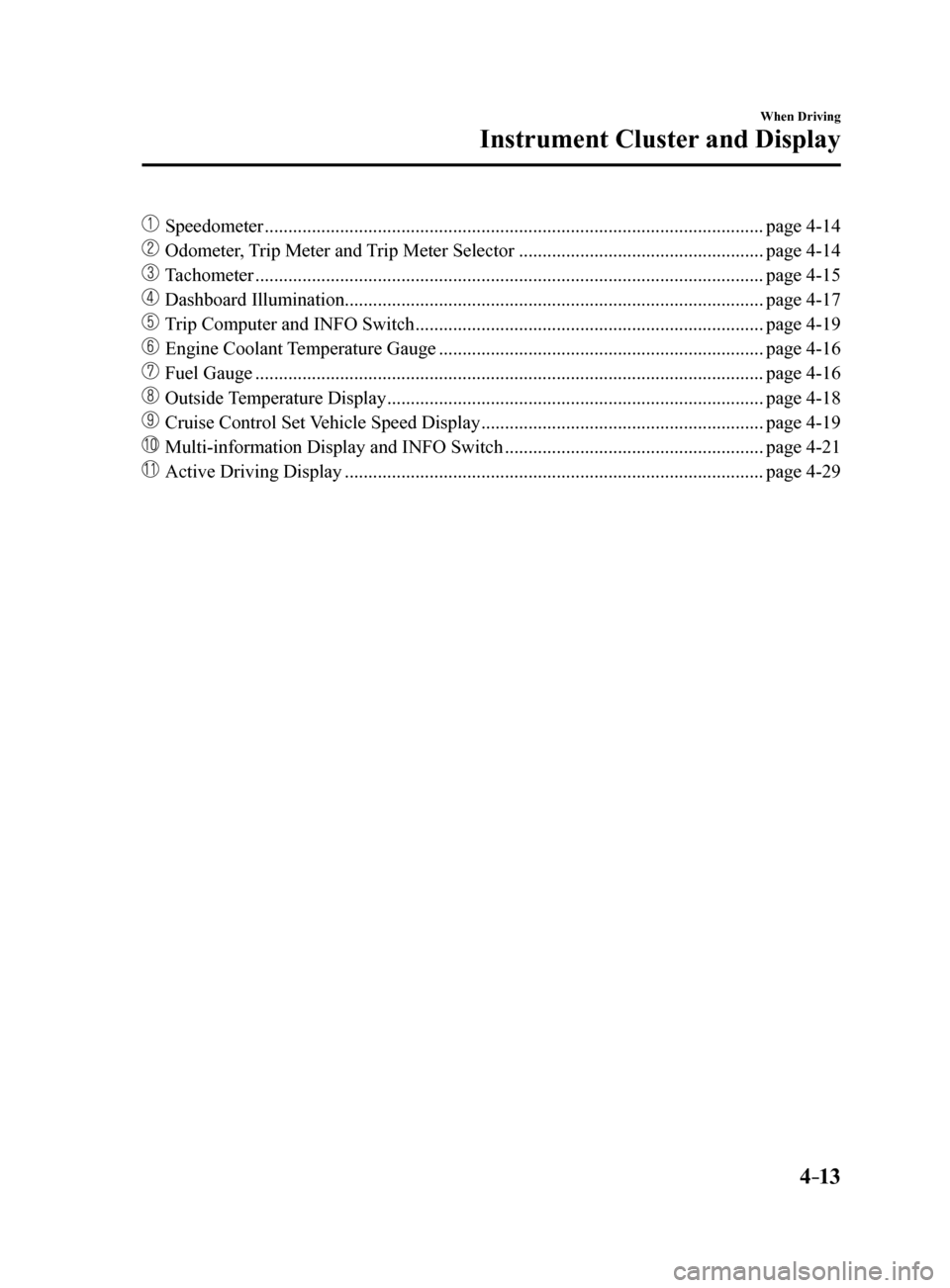
4–13
When Driving
Instrument Cluster and Display
Speedometer ........................................................................\
..................................page 4-14
Odometer, Trip Meter and Trip Meter Selector .................................................... page 4-14
Tachometer ........................................................................\
.................................... page 4-15
Dashboard Illumination ........................................................................\
................. page 4-17
Trip Computer and INFO Switch ........................................................................\
.. page 4-19
Engine Coolant Temperature Gauge ..................................................................... page 4-16
Fuel Gauge ........................................................................\
.................................... page 4-16
Outside Temperature Display ........................................................................\
........ page 4-18
Cruise Control Set Vehicle Speed Display ............................................................ page 4-19
Multi-information Display and INFO Switch ....................................................... page 4-21
Active Driving Display ........................................................................\
................. page 4-29
Mazda6_8FH2-EA-16F_Edition2.indb 132016/07/07 13:44:34
Page 141 of 578
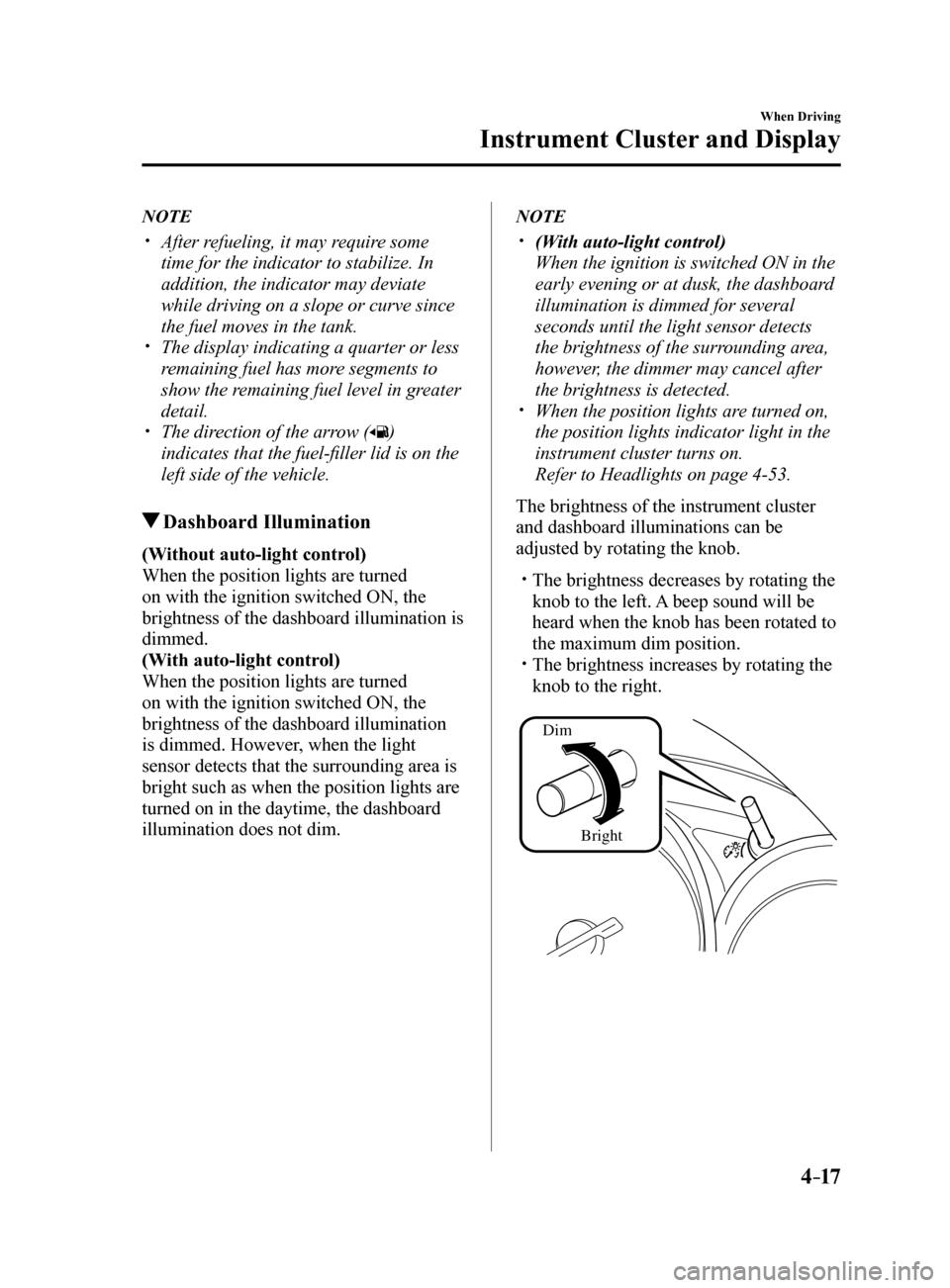
4–17
When Driving
Instrument Cluster and Display
NOTE
After refueling, it may require some
time for the indicator to stabilize. In
addition, the indicator may deviate
while driving on a slope or curve since
the fuel moves in the tank.
The display indicating a quarter or less
remaining fuel has more segments to
show the remaining fuel level in greater
detail.
The direction of the arrow ()
indicates that the fuel-filler lid is on the
left side of the vehicle.
Dashboard Illumination
(Without auto-light control)
When the position lights are turned
on with the ignition switched ON, the
brightness of the dashboard illumination is
dimmed.
(With auto-light control)
When the position lights are turned
on with the ignition switched ON, the
brightness of the dashboard illumination
is dimmed. However, when the light
sensor detects that the surrounding area is
bright such as when the position lights are
turned on in the daytime, the dashboard
illumination does not dim.
NOTE
(With auto-light control)
When the ignition is switched ON in the
early evening or at dusk, the dashboard
illumination is dimmed for several
seconds until the light sensor detects
the brightness of the surrounding area,
however, the dimmer may cancel after
the brightness is detected.
When the position lights are turned on,
the position lights indicator light in the
instrument cluster turns on.
Refer to Headlights on page 4-53.
The brightness of the instrument cluster
and dashboard illuminations can be
adjusted by rotating the knob.
The brightness decreases by rotating the
knob to the left. A beep sound will be
heard when the knob has been rotated to
the maximum dim position.
The brightness increases by rotating the
knob to the right.
Dim
Bright
Mazda6_8FH2-EA-16F_Edition2.indb 172016/07/07 13:44:36
Page 142 of 578
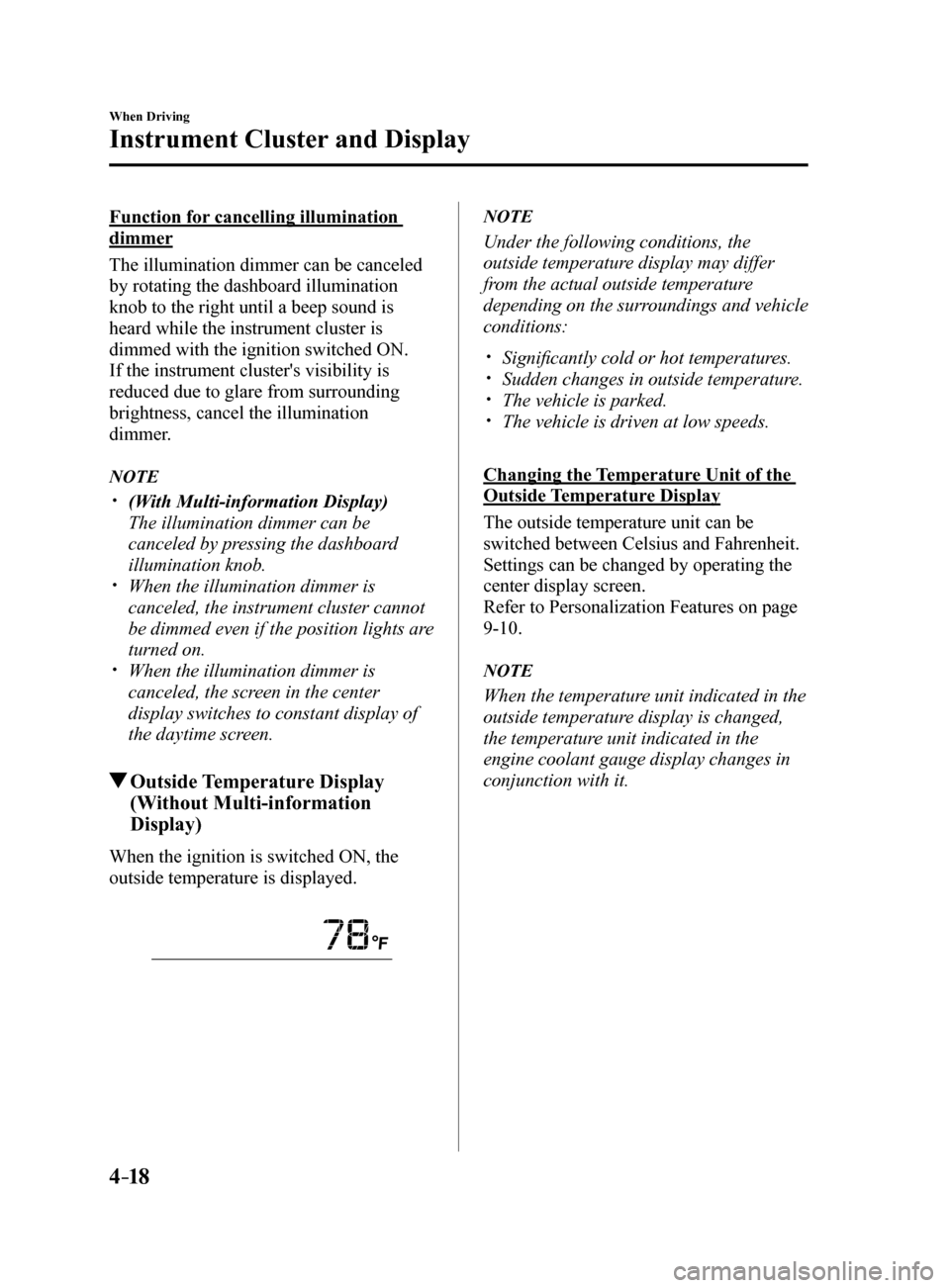
4–18
When Driving
Instrument Cluster and Display
Function for cancelling illumination
dimmer
The illumination dimmer can be canceled
by rotating the dashboard illumination
knob to the right until a beep sound is
heard while the instrument cluster is
dimmed with the ignition switched ON.
If the instrument cluster's visibility is
reduced due to glare from surrounding
brightness, cancel the illumination
dimmer.
NOTE
(With Multi-information Display)
The illumination dimmer can be
canceled by pressing the dashboard
illumination knob.
When the illumination dimmer is
canceled, the instrument cluster cannot
be dimmed even if the position lights are
turned on.
When the illumination dimmer is
canceled, the screen in the center
display switches to constant display of
the daytime screen.
Outside Temperature Display
(Without Multi-information
Display)
When the ignition is switched ON, the
outside temperature is displayed.
NOTE
Under the following conditions, the
outside temperature display may differ
from the actual outside temperature
depending on the surroundings and vehicle
conditions:
Significantly cold or hot temperatures. Sudden changes in outside temperature. The vehicle is parked. The vehicle is driven at low speeds.
Changing the Temperature Unit of the
Outside Temperature Display
The outside temperature unit can be
switched between Celsius and Fahrenheit.
Settings can be changed by operating the
center display screen.
Refer to Personalization Features on page
9-10.
NOTE
When the temperature unit indicated in the
outside temperature display is changed,
the temperature unit indicated in the
engine coolant gauge display changes in
conjunction with it.
Mazda6_8FH2-EA-16F_Edition2.indb 182016/07/07 13:44:36
Page 156 of 578
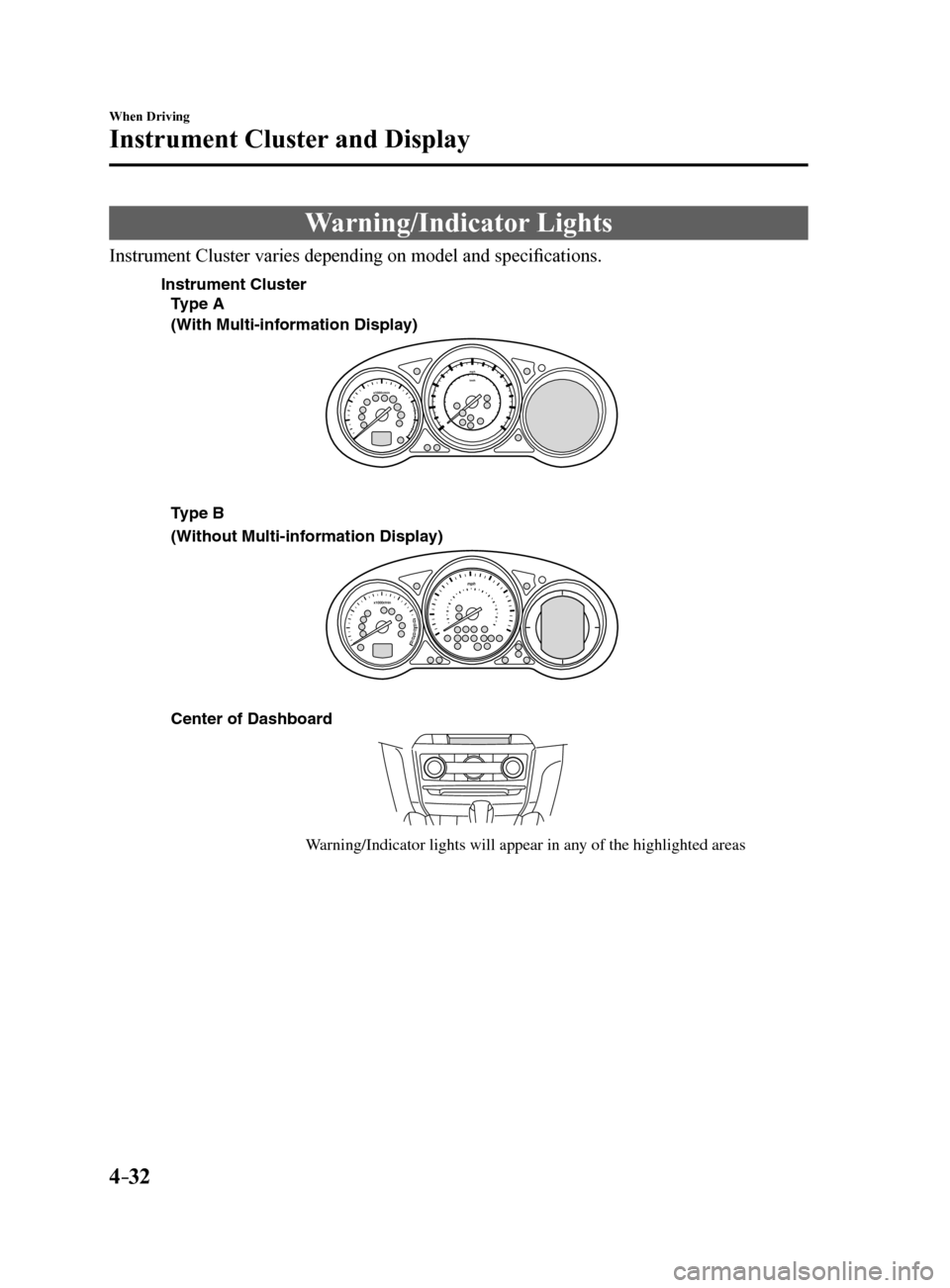
4–32
When Driving
Instrument Cluster and Display
Warning/Indicator Lights
Instrument Cluster varies depending on model and specifications.
Center of Dashboard
W arning/Indicator lights will appear in an y of the highlighted areas
T
ype A
(With Multi-inf ormation Displa y)
(Without Multi-inf ormation Display)
Instrument Cluster
Type B
Mazda6_8FH2-EA-16F_Edition2.indb 322016/07/07 13:44:42
Page 222 of 578
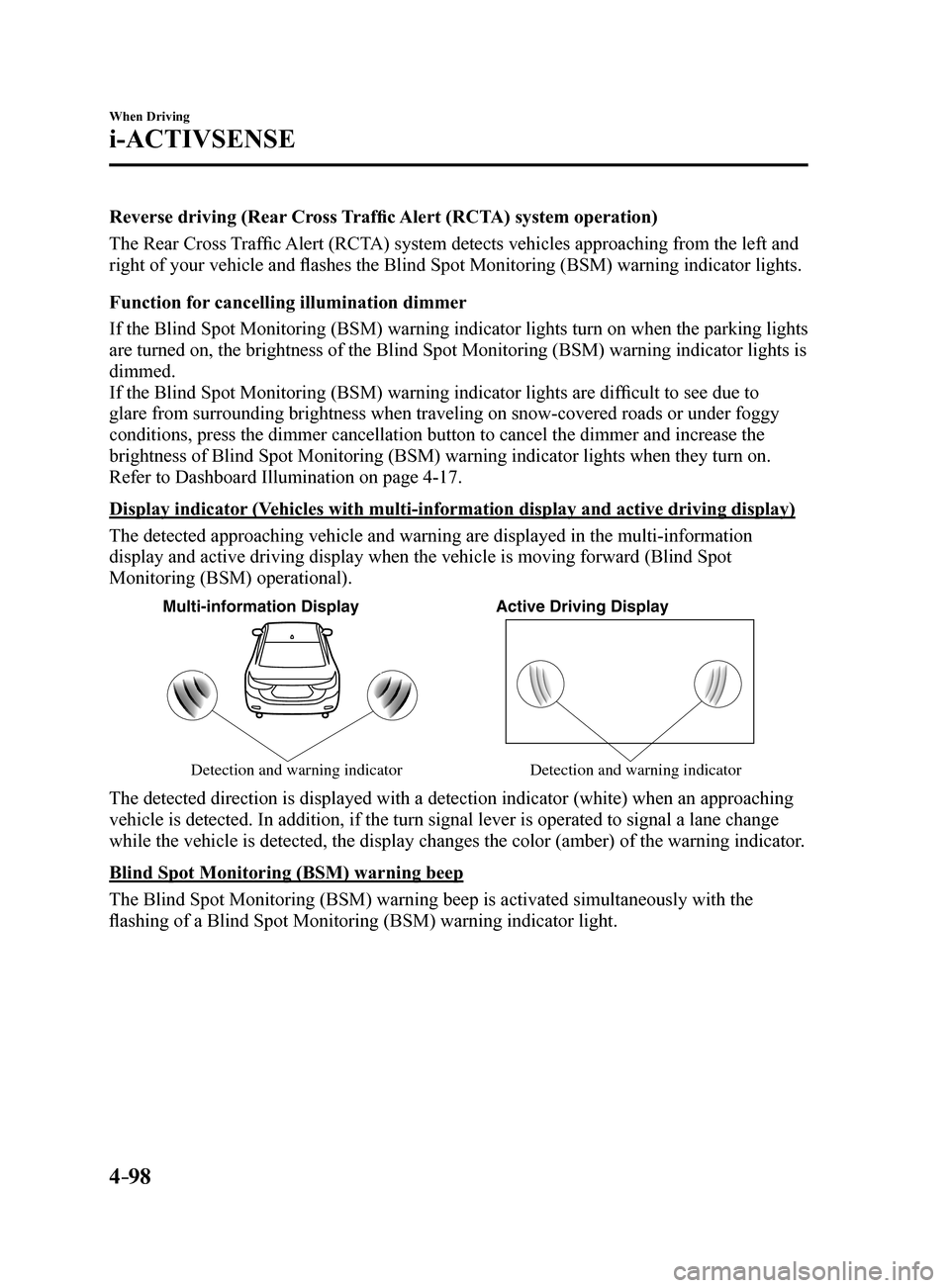
4–98
When Driving
i-ACTIVSENSE
Reverse driving (Rear Cross Traffic Alert (RCTA) system operation)
The Rear Cross Traffic Alert (RCTA) system detects vehicles approaching from the left and
right of your vehicle and flashes the Blind Spot Monitoring (BSM) warning indicator lights.
Function for cancelling illumination dimmer
If the Blind Spot Monitoring (BSM) warning indicator lights turn on when the parking lights
are turned on, the brightness of the Blind Spot Monitoring (BSM) warning indicator lights is
dimmed.
If the Blind Spot Monitoring (BSM) warning indicator lights are difficult to see due to
glare from surrounding brightness when traveling on snow-covered roads o\
r under foggy
conditions, press the dimmer cancellation button to cancel the dimmer an\
d increase the
brightness of Blind Spot Monitoring (BSM) warning indicator lights when they turn on.
Refer to Dashboard Illumination on page 4-17.
Display indicator (Vehicles with multi-information display and active driving display)
The detected approaching vehicle and warning are displayed in the multi-\
information
display and active driving display when the vehicle is moving forward (Blind Spot
Monitoring (BSM) operational).
Multi-information DisplayActive Driving Display
Detection and warning indicator Detection and warning indicator
The detected direction is displayed with a detection indicator (white)\
when an approaching
vehicle is detected. In addition, if the turn signal lever is operated t\
o signal a lane change
while the vehicle is detected, the display changes the color (amber) o\
f the warning indicator.
Blind Spot Monitoring (BSM) warning beep
The Blind Spot Monitoring (BSM) warning beep is activated simultaneously with the
flashing of a Blind Spot Monitoring (BSM) warning indicator light.
Mazda6_8FH2-EA-16F_Edition2.indb 982016/07/07 13:45:06
Page 226 of 578
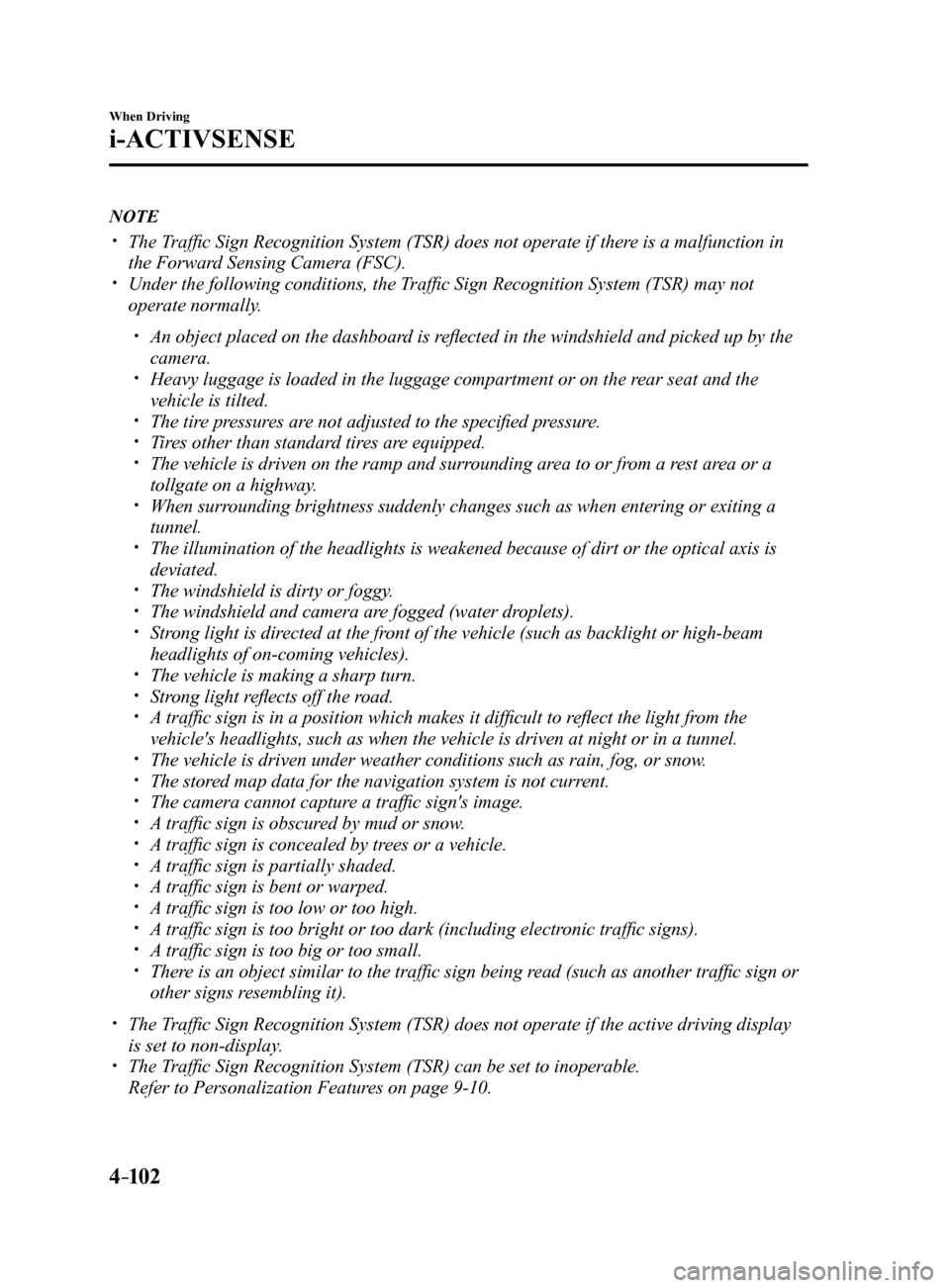
4–102
When Driving
i-ACTIVSENSE
NOTE
The Traffic Sign Recognition System (TSR) does not operate if there is a malfunction in
the Forward Sensing Camera (FSC).
Under the following conditions, the Traffic Sign Recognition System (TSR) may not
operate normally.
An object placed on the dashboard is reflected in the windshield and picked up by the
camera.
Heavy luggage is loaded in the luggage compartment or on the rear seat and the
vehicle is tilted.
The tire pressures are not adjusted to the specified pressure. Tires other than standard tires are equipped. The vehicle is driven on the ramp and surrounding area to or from a rest area or a
tollgate on a highway.
When surrounding brightness suddenly changes such as when entering or exiting a
tunnel.
The illumination of the headlights is weakened because of dirt or the op\
tical axis is
deviated.
The windshield is dirty or foggy. The windshield and camera are fogged (water droplets). Strong light is directed at the front of the vehicle (such as backlight or high-beam
headlights of on-coming vehicles).
The vehicle is making a sharp turn. Strong light reflects off the road. A traffic sign is in a position which makes it difficult to reflect the light from the
vehicle's headlights, such as when the vehicle is driven at night or in \
a tunnel.
The vehicle is driven under weather conditions such as rain, fog, or sno\
w. The stored map data for the navigation system is not current. The camera cannot capture a traffic sign's image. A traffic sign is obscured by mud or snow. A traffic sign is concealed by trees or a vehicle. A traffic sign is partially shaded. A traffic sign is bent or warped. A traffic sign is too low or too high. A traffic sign is too bright or too dark (including electronic traffic signs). A traffic sign is too big or too small. There is an object similar to the traffic sign being read (such as another traffic sign or
other signs resembling it).
The Traffic Sign Recognition System (TSR) does not operate if the active driving display
is set to non-display.
The Traffic Sign Recognition System (TSR) can be set to inoperable.
Refer to Personalization Features on page 9-10.
Mazda6_8FH2-EA-16F_Edition2.indb 1022016/07/07 13:45:07
Page 252 of 578
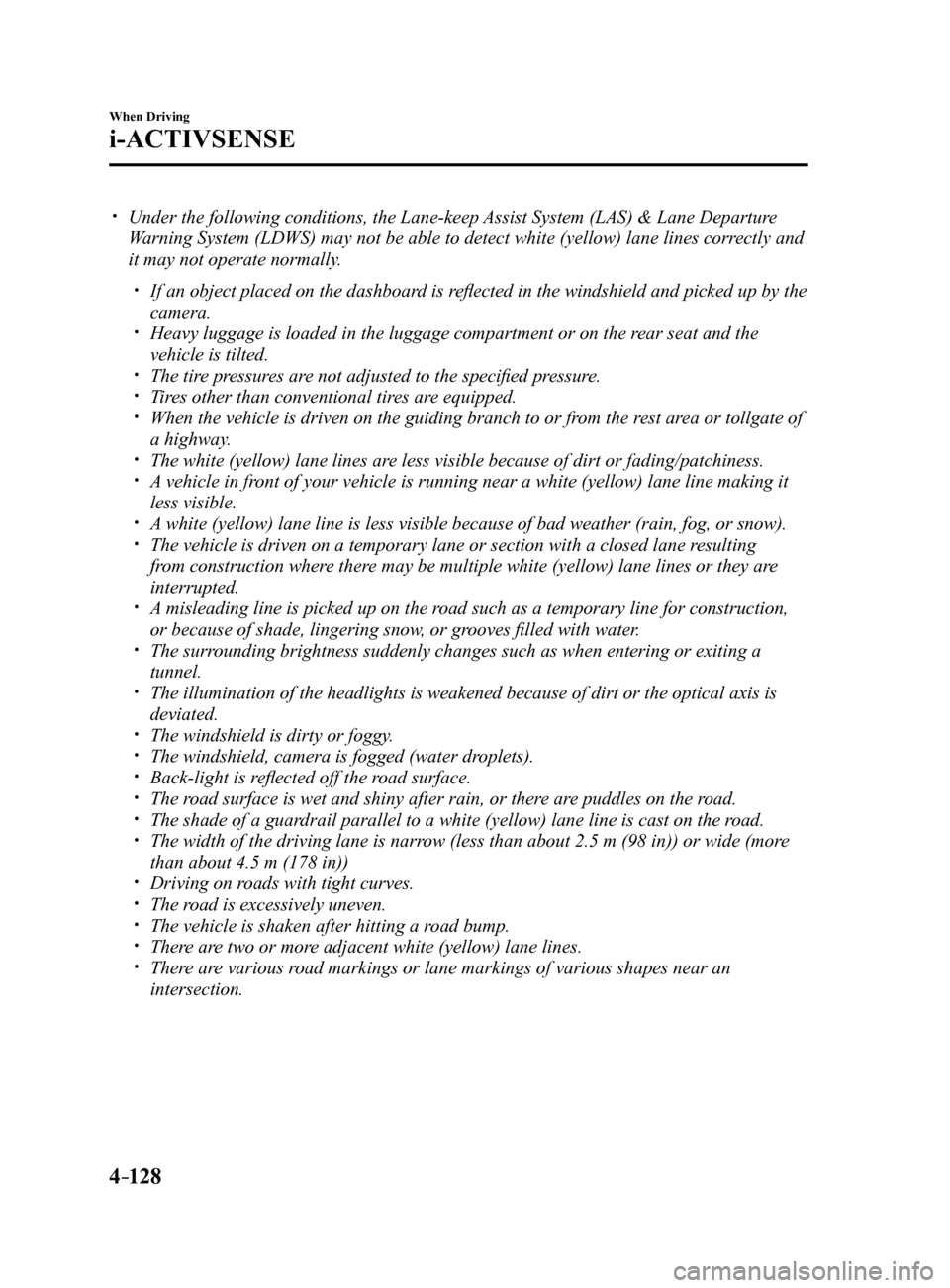
4–128
When Driving
i-ACTIVSENSE
Under the following conditions, the Lane-keep Assist System (LAS) & Lane Departure
Warning System (LDWS) may not be able to detect white (yellow) lane l\
ines correctly and
it may not operate normally.
If an object placed on the dashboard is reflected in the windshield and picked up by the
camera.
Heavy luggage is loaded in the luggage compartment or on the rear seat and the
vehicle is tilted.
The tire pressures are not adjusted to the specified pressure. Tires other than conventional tires are equipped. When the vehicle is driven on the guiding branch to or from the rest area or tollgate of
a highway.
The white (yellow) lane lines are less visible because of dirt or fading/patchiness. A vehicle in front of your vehicle is running near a white (yellow) lane line making \
it
less visible.
A white (yellow) lane line is less visible because of bad weather (rai\
n, fog, or snow). The vehicle is driven on a temporary lane or section with a closed lane \
resulting
from construction where there may be multiple white (yellow) lane lines or they are
interrupted.
A misleading line is picked up on the road such as a temporary line for construction,
or because of shade, lingering snow, or grooves filled with water.
The surrounding brightness suddenly changes such as when entering or exiting a
tunnel.
The illumination of the headlights is weakened because of dirt or the op\
tical axis is
deviated.
The windshield is dirty or foggy. The windshield, camera is fogged (water droplets). Back-light is reflected off the road surface. The road surface is wet and shiny after rain, or there are puddles on the road. The shade of a guardrail parallel to a white (yellow) lane line is cast on the road. The width of the driving lane is narrow (less than about 2.5 m (98 in)) or wide (more
than about 4.5 m (178 in))
Driving on roads with tight curves. The road is excessively uneven. The vehicle is shaken after hitting a road bump. There are two or more adjacent white (yellow) lane lines. There are various road markings or lane markings of various shapes near an
intersection.
Mazda6_8FH2-EA-16F_Edition2.indb 1282016/07/07 13:45:16
Page 271 of 578
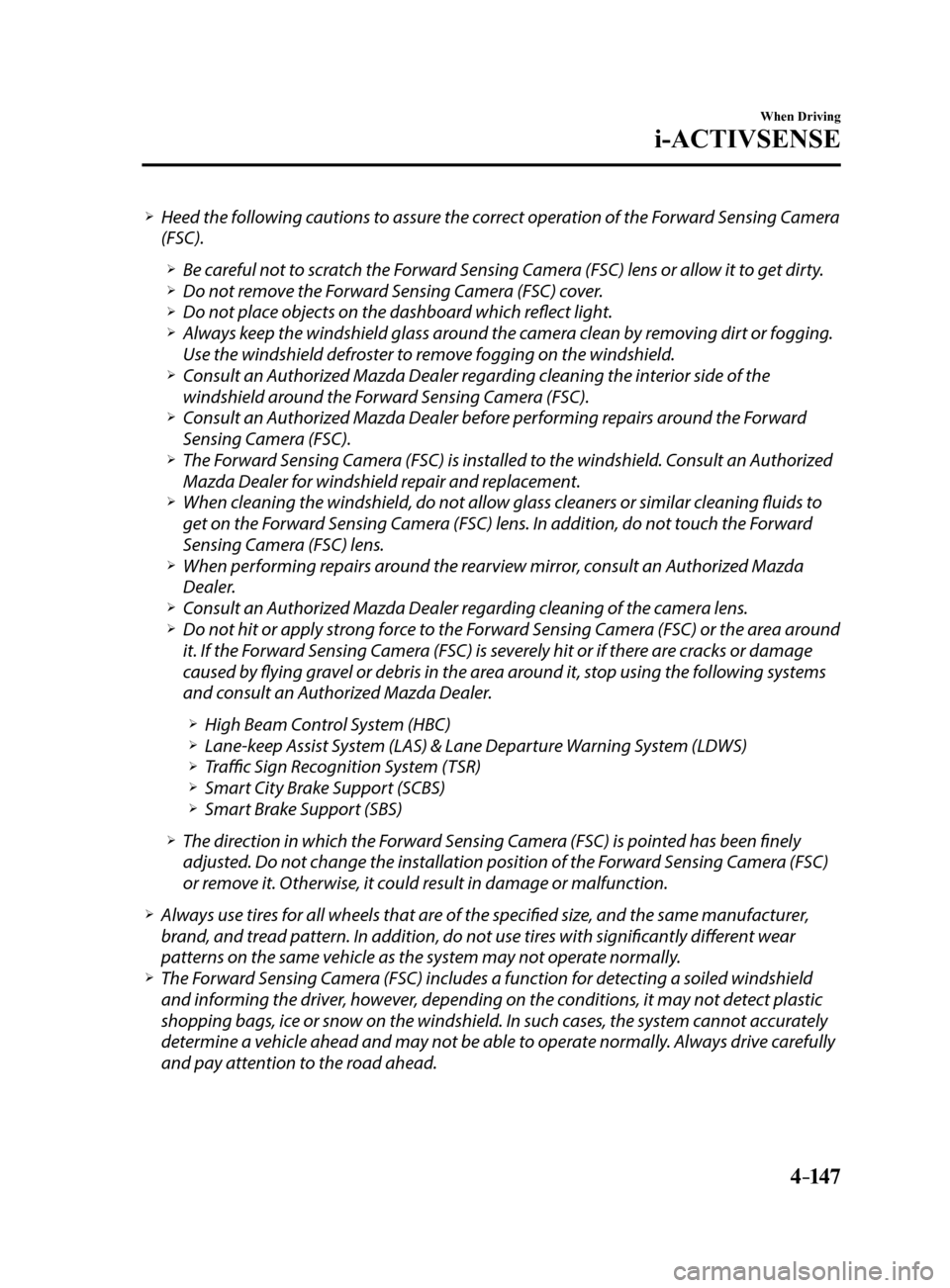
4–147
When Driving
i-ACTIVSENSE
Heed the following cautions to assure the correct operation of the Forward Sensing Camera
(FSC).
Be careful not to scratch the Forward Sensing Camera (FSC) lens or allow it to get dirty. Do not remove the Forward Sensing Camera (FSC) cover. Do not place objects on the dashboard which reflect light. Always keep the windshield glass around the camera clean by removing dirt or fogging.
Use the windshield defroster to remove fogging on the windshield.
Consult an Authorized Mazda Dealer regarding cleaning the interior side of the
windshield around the Forward Sensing Camera (FSC).
Consult an Authorized Mazda Dealer before performing repairs around the Forward
Sensing Camera (FSC).
The Forward Sensing Camera (FSC) is installed to the windshield. Consult an Authorized
Mazda Dealer for windshield repair and replacement.
When cleaning the windshield, do not allow glass cleaners or similar cleaning fluids to
get on the Forward Sensing Camera (FSC) lens. In addition, do not touch the Forward
Sensing Camera (FSC) lens.
When performing repairs around the rearview mirror, consult an Authorized Mazda
Dealer.
Consult an Authorized Mazda Dealer regarding cleaning of the camera lens. Do not hit or apply strong force to the Forward Sensing Camera (FSC) or the area around
it. If the Forward Sensing Camera (FSC) is severely hit or if there are cracks or damage
caused by flying gravel or debris in the area around it, stop using the following systems
and consult an Authorized Mazda Dealer.
High Beam Control System (HBC) Lane-keep Assist System (LAS) & Lane Departure Warning System (LDWS) Traffic Sign Recognition System (TSR) Smart City Brake Support (SCBS) Smart Brake Support (SBS)
The direction in which the Forward Sensing Camera (FSC) is pointed has been finely
adjusted. Do not change the installation position of the Forward Sensing Camera (FSC)
or remove it. Otherwise, it could result in damage or malfunction.
Always use tires for all wheels that are of the specified size, and the same manufacturer,
brand, and tread pattern. In addition, do not use tires with significantly different wear
patterns on the same vehicle as the system may not operate normally.
The Forward Sensing Camera (FSC) includes a function for detecting a soiled windshield
and informing the driver, however, depending on the conditions, it may not detect plastic
shopping bags, ice or snow on the windshield. In such cases, the system cannot accurately
determine a vehicle ahead and may not be able to operate normally. Always drive carefully
and pay attention to the road ahead.
Mazda6_8FH2-EA-16F_Edition2.indb 1472016/07/07 13:45:20
Page 554 of 578

9–2
Specifications
Identification Numbers
Vehicle Information Labels
Vehicle Identification Number
The vehicle identification number legally
identifies your vehicle. The number is on a
plate attached to the cowl panel located on
the left corner of the dashboard. This plate
can easily be seen through the windshield.
Motor Vehicle Safety Standard
Label (U.S.A. and Canada)
Chassis Number
Open the cover shown in the figure to
check the chassis number.
Vehicle Emission Control
Information Label (U.S.A. and
Canada)
Tire Pressure Label
Mazda6_8FH2-EA-16F_Edition2.indb 22016/07/07 13:46:47
Page 571 of 578
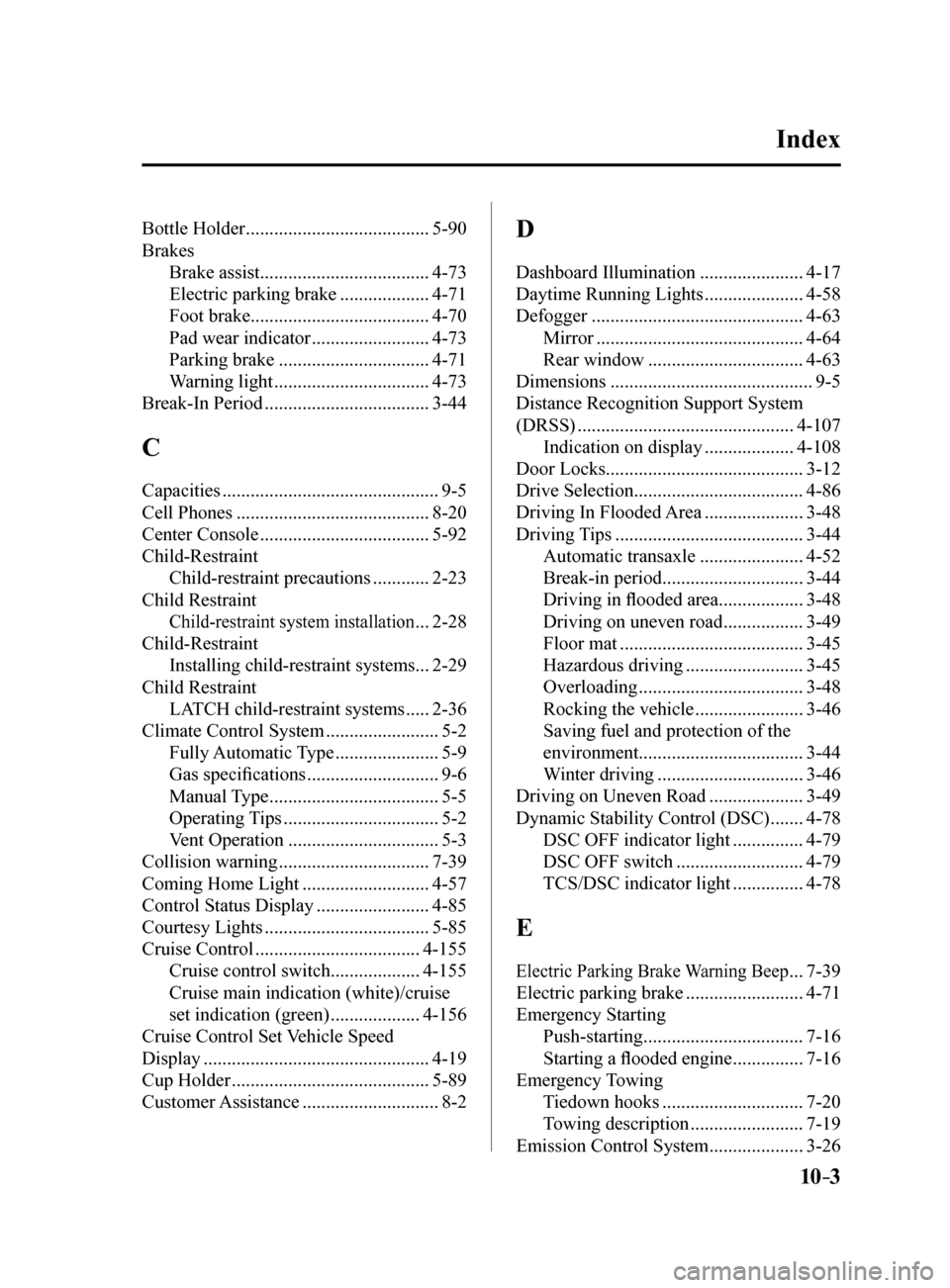
10–3
Index
Bottle Holder .......................................5-90
Brakes Brake assist .................................... 4-73
Electric parking brake ................... 4-71
Foot brake ...................................... 4-70
Pad wear indicator ......................... 4-73
Parking brake ................................ 4-71
Warning light ................................. 4-73
Break-In Period ................................... 3-44
C
Capacities .............................................. 9-5
Cell Phones ......................................... 8-20
Center Console .................................... 5-92
Child-Restraint Child-restraint precautions ............ 2-23
Child Restraint
Child-restraint system installation ... 2-28
Child-Restraint Installing child-restraint systems ...2-29
Child Restraint LATCH child-restraint systems ..... 2-36
Climate Control System ........................5-2
Fully Automatic Type ...................... 5-9
Gas specifications ............................ 9-6
Manual Type .................................... 5-5
Operating Tips ................................. 5-2
Vent Operation ................................ 5-3
Collision warning ................................ 7-39
Coming Home Light ........................... 4-57
Control Status Display ........................ 4-85
Courtesy Lights ................................... 5-85
Cruise Control ................................... 4-155
Cruise control switch ...................4-155
Cruise main indication (white)/cruise
set indication (green) ................... 4-156
Cruise Control Set Vehicle Speed
Display ................................................ 4-19
Cup Holder .......................................... 5-89
Customer Assistance ............................. 8-2
D
Dashboard Illumination ......................4-17
Daytime Running Lights ..................... 4-58
Defogger ............................................. 4-63
Mirror ............................................ 4-64
Rear window ................................. 4-63
Dimensions ........................................... 9-5
Distance Recognition Support System
(DRSS) .............................................. 4-107
Indication on display ................... 4-108
Door Locks .......................................... 3-12
Drive Selection .................................... 4-86
Driving In Flooded Area ..................... 3-48
Driving Tips ........................................ 3-44
Automatic transaxle ...................... 4-52
Break-in period .............................. 3-44
Driving in flooded area ..................3-48
Driving on uneven road ................. 3-49
Floor mat ....................................... 3-45
Hazardous driving ......................... 3-45
Overloading ................................... 3-48
Rocking the vehicle ....................... 3-46
Saving fuel and protection of the
environment ................................... 3-44
Winter driving ............................... 3-46
Driving on Uneven Road .................... 3-49
Dynamic Stability Control (DSC) ....... 4-78
DSC OFF indicator light ............... 4-79
DSC OFF switch ........................... 4-79
TCS/DSC indicator light ............... 4-78
E
Electric Parking Brake Warning Beep ...7-39
Electric parking brake ......................... 4-71
Emergency Starting Push-starting .................................. 7-16
Starting a flooded engine ............... 7-16
Emergency Towing Tiedown hooks .............................. 7-20
Towing description ........................ 7-19
Emission Control System .................... 3-26
Mazda6_8FH2-EA-16F_Edition2.indb 32016/07/07 13:46:50